
Issue #: 162
Published: November / December 2018
- Price per issue - digital : 6.20€Digital magazine
- Price per issue - print : 8.50€Print magazine
- Access to Multihulls World digital archives Digital archives
Gitana: A family of prestigious, classic boats
In 1876, Baroness Julie de Rothschild commissioned Thornycroft shipyard to build a 24.45m record steamer. The first of the Gitanas would be timed on Lake Geneva at 20.5 knots (an extraordinary speed for the period!): the world record! The Gitana saga had begun! In the 1960s, Baron Benjamin (founder of the financial group in 1953) revived the family enthusiasm for boating and racing.

The transformation into a racing team mainly dedicated to multihulls
In 2000 Ariane and Benjamin de Rothschild established a real competition team that recruits its skippers from among the cream of the crop: Fred Le Peutrec, Loïck Peyron, Jean Le Cam, Thierry Duprey Du Vorsent and Lionel Lemonchois have been among those elected. The first racing trimaran was the former Elf III, now Gitana IX (Designed by G.Ollier - Multiplast). Then came the first boat entirely developed by the team: Gitana X. Its design was already based on the characteristics that were to become the hallmark of the team: daring techniques and aesthetics were being sought. The X was the product of a unique collaboration (something not yet undertaken in 2002!) between Gilles Ollier, Sebastien Schmidt, Mario Caponnetto and Duncan Mac Lane. Geared towards performance at Grand Prix level, this boat with X-arms was a little fragile for ocean racing.
By now the team had gained experience and made the informed choice of the acquisition of Jean Luc Nélias' ex-Belgacom (VPLP / Larros / CDK). Fred Le Peutrec and Loïck Peyron were the skippers, before Lionel Lemonchois' fantastic ride in the 2006 Route du Rhum, with an incredible victory in 7 days 17 hours! It was one of the most fantastic performances in this race since its inception. The boat was then to be transformed and extended by 17' to be eligible for the new Ultim class, and would then come 4th in the 2010 Route du Rhum, with Yann Guichard. Gitana 12 (formerly Jean Le Cam’s Bonduelle) was to be the team’s last Orma before the acquisition of one of the 4 giants of the time: Loïck Peyron’s former Innovation Explorer. Perfectly prepared, the big catamaran measuring 32.80m set out on a series of ocean records in 2008. From 2009 through 2012, the one-design circuit of the Extreme40 Sailing Series mobilized the team's multihull activity with Pierre Pennec at the helm. In 2011, the Mod 70 series started to look promising: one-design with a dynamic calendar. The bar had been raised! An ideal boat for the team. Alas the system rapidly collapsed: Sébastien Josse and Charles Caudrelier’s victory in the Transat Jacques Vabre was to be the high point of the adventure. Transformed into an experimental flying trimaran, which makes L foils progress quickly (the most efficient at the time), the Mod 70 Gitana 15 returned under the hand of Guillaume Verdier (one of the pioneers of the Team New Zealand foiler during the America’s Cup). This boat was to become the first modern ocean foiler: it paved the way for Gitana 17:Edmond de Rothschild.
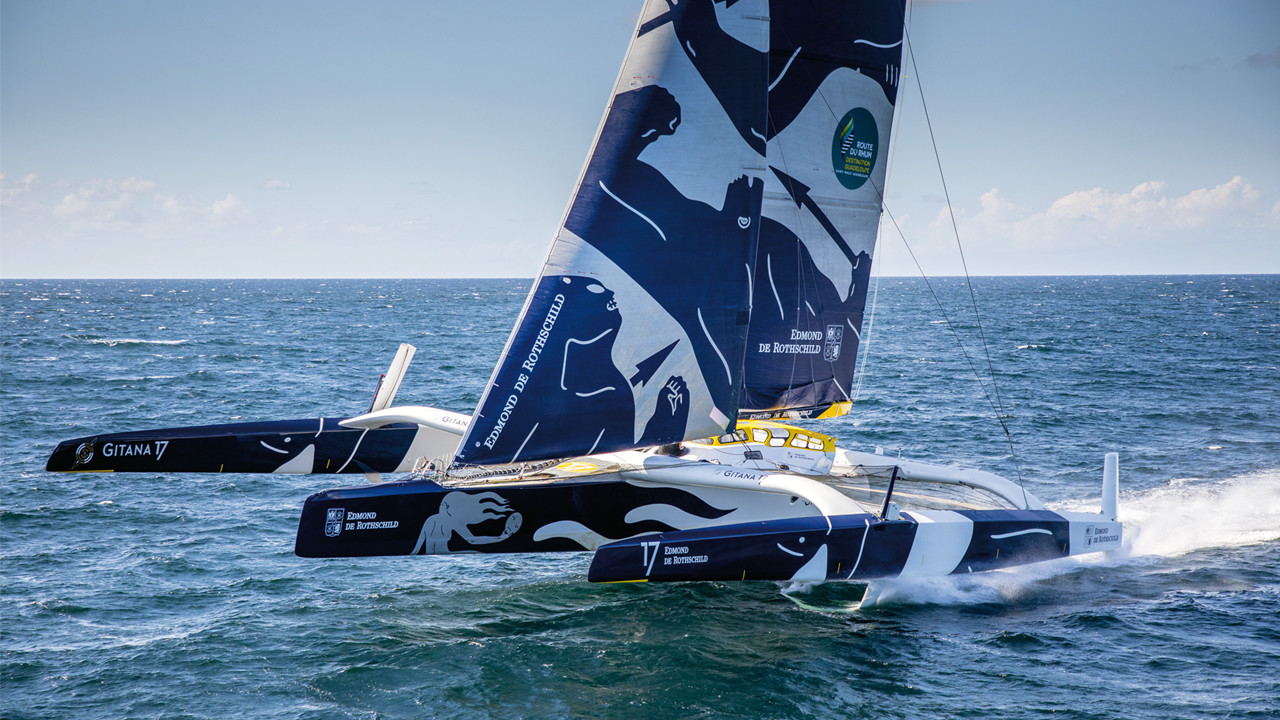
Gitana 17:Edmond de Rothschild, the first flying Ultim trimaran
Launched after Macif (CDK/VPLP in original Archimedean version, holder of the single-handed round the world record), but before Banque Populaire IX (CDK/VPLP), Gitana 17 was a born foiler: Guillaume Verdier's radical and highly innovative design is characterized by rectangular section arms, streamlined and without curvature (for better platform rigidity and increased reliability), a very large elevation of the topsides of the floats and optimized aerodynamics. From a hydrodynamic point of view, the flat U-shaped float and hull sections provide the planing shapes that maximize lift and avoid getting "sucked down". These flat bottoms in monolithic carbon also play a stiffening role to counteract the twisting loads on the foils when in action (50 tonnes!). The boat was designed around its appendages at the end of the Mod70 test campaign: 3 inverted T-rudder blades, 2 L-shaped foils with XXL dimensions (5.40m!), and a central T-shaped daggerboard with trimmer and flap at the extremity. Maximum height on the water, maximum platform stiffness and minimum aero and hydrodynamic drag: these are the parameters of this aggressive and futuristic design.
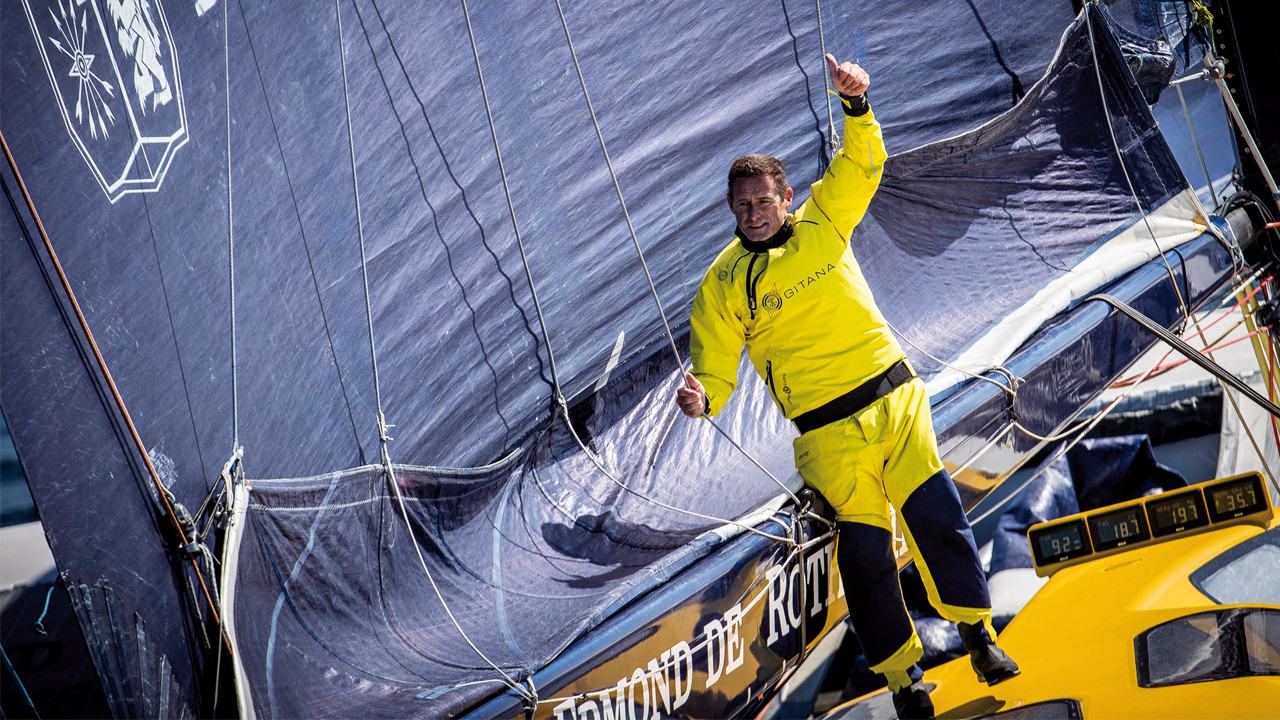
The technical, conceptual and financial challenge
If the figures make us dizzy, they also express the reality of design and manufacture of such a speed machine that is actually evolving for the first time in the air-water interface. These 15.5 tons of black fiber required the investment of 250 stakeholders in all. These included 40 composites specialists who spent 20 months on its production, 35,000 hours of design team time and 135,000 hours of construction! The complex mobile appendages of such a flying machine have required the intervention of 3 different manufacturers in order not to risk weakening a company in case of default on one of the parts (the two foils cost €500,000 for example!). Eligio Re Fraschini (foils) is a strong, high-tech company specializing in the manufacture of Formula 1 chassis, avionics composite parts and large-vessel propellers; Heol's Morbihan team has an extraordinary mastery of hollow carbon parts and pre-impregnated material in general. This composites alchemist put together the central daggerboard with its trimmer and end flaps. C3 Technologie in La Rochelle operates in the same areas and also manufactures all-carbon passenger aircraft. Here’s are some amazing numbers: Foils with a height of 5.50m withstand up to 130t of load before breaking! The construction budget of the boat: €15M; the annual budget of the team: €3.5 M (but compare this with the budget, for example, of the Sky cycling team: €35 M!! And they’re not even building an innovative boat!
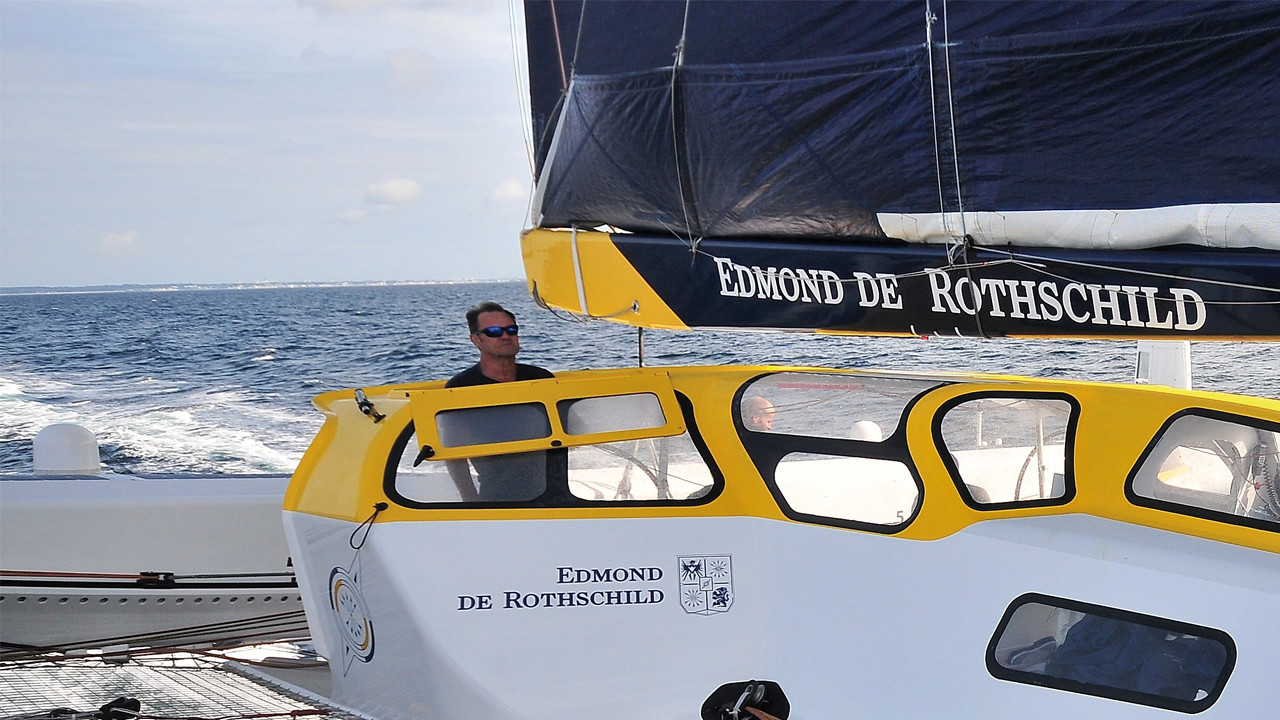
Just a perfect day!
I’m sure Lou Reed will forgive me for borrowing this from one of his iconic songs, but these are the words that came to my mind when I left the maxi foiler. Some notes on a Steinway, a heady, addictive melody, a song that transcends time! My experiences of multihull flight are very limited: Some runs in Windrider Rave in the late 90s, the AC50 Groupama; the TF30 trimaran and finally Gitana 17. However, sailing each of these boats gave me an intense pleasure and revived my passion for multihulls! With these machines, life starts at 20 knots, explodes at 30 and reaches a climax at 40! Ocean flight isn’t 5 years old, but for a new generation of Jedi-navigators it opens a revolutionary sector in the sailing experience. It was the magicians of the appendages who made this miracle possible!
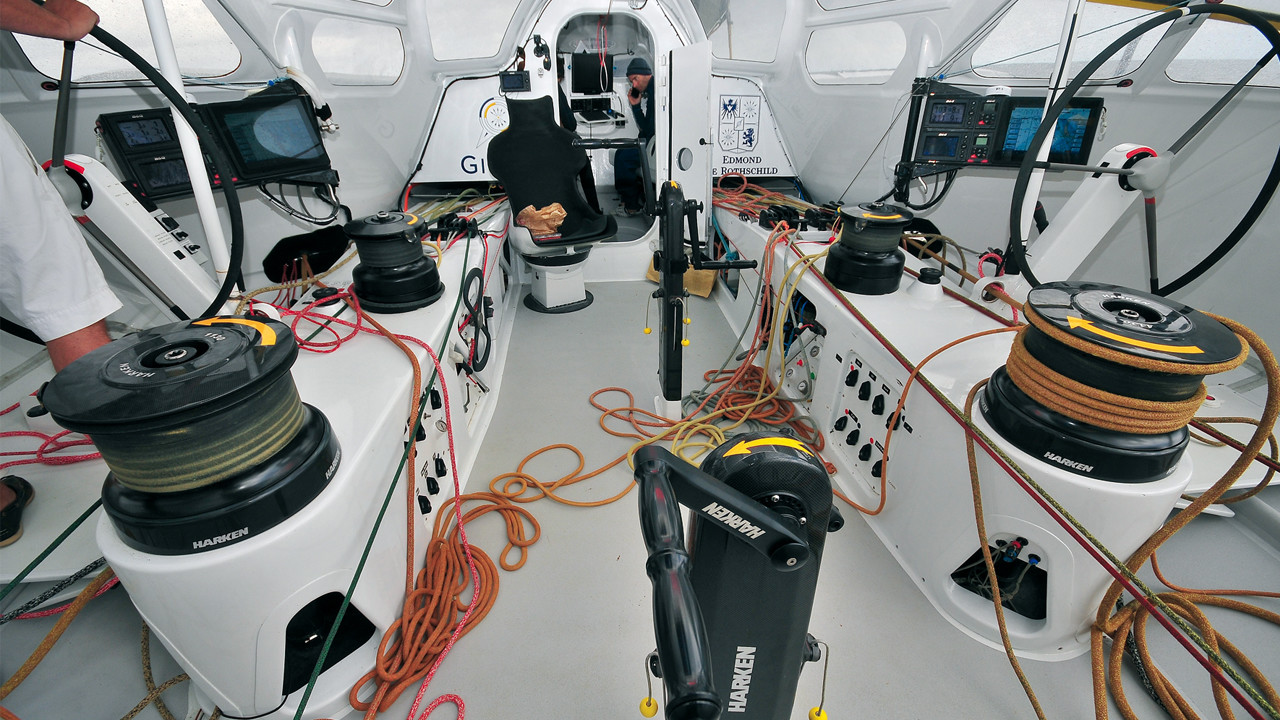
Our trip took place at the end of a night out with a small crew off the coast of Brittany. The crew: (Thomas Rouxel, Sébastien Josse, his teammate in the Transat Jacques Vabre, Nicolas Lunven who will be in charge of weather routing for the 2018 Route du Rhum and Sébastien Sainson who is a naval architect who graduated from Southampton, and is a member of the design team) We joined the trimaran SE of the Ile de Groix. The mastodon descended towards us with the wind behind and the mainsail sheet in to slow her down and stabilize her. A spectacular fender staircase is set up from the big 10m tender to allow us access on board. Immediately, we are in for a collective 5 minute session of effort (with 4 of us!) on the grinders to lower the port foil (the biggest winch has been designed as a one-off by Harken USA for a permanent workload of 9 tonnes)! The rudders and the daggerboard are in the lowered position, and the foil raked at 3° (a positive impact out of the possible 4°). We then unfurled the solent (again, sizeable effort is required and there are 4 of us on the grinders)! Sheeted hard in (as always on this kind of boat where the apparent wind is always very close to dead ahead, whatever the speed, this sailing rocket takes off in 12 knots of wind. Thomas Rouxel is at the wheel where the jumbo display regularly shows 25 knots of boatspeed when, suddenly, at 90° to the true wind that goes up to 15-16 knots, the powdery wake becomes huge, the speedo panics and the appendages pull us free from earthly attraction! 32 knots, the trimaran’s trim is so perfect that it seems unreal. We are flying! Sébastien Josse offers me the chance to take the helm. Well-secured on the navigating platform, titanium rim in hand, I poke my head through the opening roof and find myself in an exclusive, exceptional universe, that of one of the 5 Ultim multihulls which exist in the world.
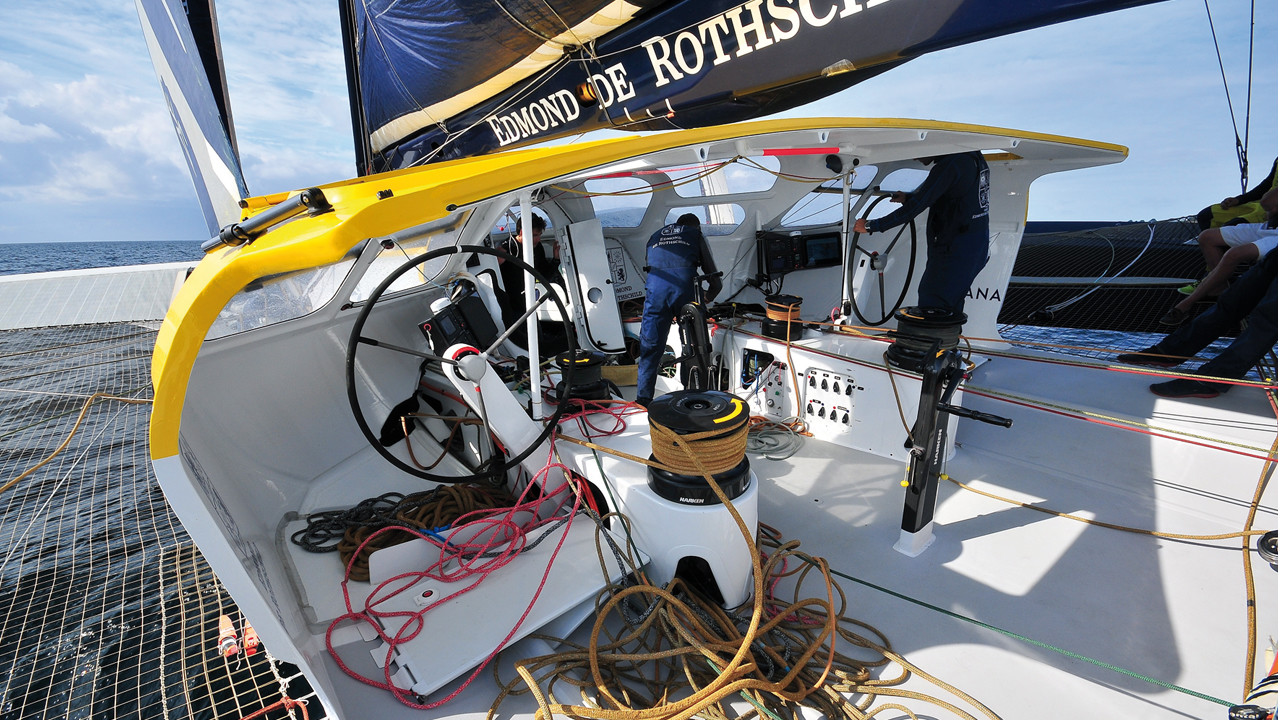
The helm sensation is quite a shock at first, but you get used to the size of the machine quickly. Sitting between 82 and 90° off an irregular wind, I manage to keep the machine in flight and semi-flight. The transitions between the Archimedean sequences and the 5-point takeoff are smooth, as is the landing. It’s extraordinary! The noise coming from aft is powerful, but the noise level of the appendages (perceived from the outside) is low; not at all like the wild beast howls of an AC50. The wind speed, just unbearable for a long time, is the reason why the navigation capsule includes the helm station and all the sail handling controls. A small removable windshield completes the device to help fight against the spray! In these ideal conditions, the speed is maintained between 22 and 36 knots and the steady behavior is so perfect that one has the impression of sailing on a well-honed, long-developed machine, whereas in reality, the job list is always full at the end of each test run.
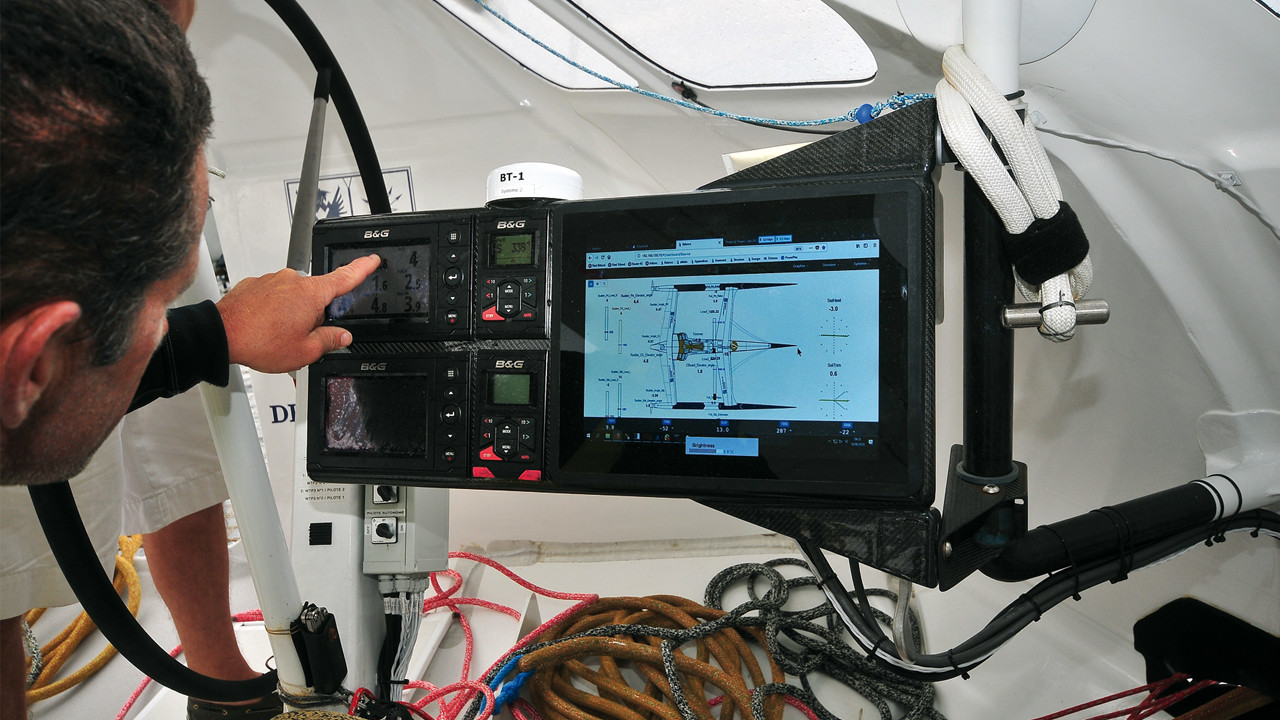
Helming in this type of weather is not difficult, but it becomes a bit more complicated as soon as we observe the screen that summarizes the parameters of the appendages! Maintaining it in flight assumes fine adjustments (too much drag: it brakes and we don’t take off - not enough impact: it won’t fly)! And with the automatic servo-control of these parameters being unavailable for the moment, the skipper is obliged to adopt an average "menu" because it is impossible to intervene permanently on the 5 points of contact with the water! Gitana 17 is loaded with sensors, and there is a program developed in-house with computer scientists from the research office headed by Romain Ingouff, which automates all actions of the flight (don’t say a word though, it's top secret!) ... but it can’t be used in the race! Aboard these extremely physical boats, you need to be wary - releasing the sheet or the traveler too early means you have to take it in again and that requires a huge amount of effort to avoid exposing you to other consequences ... Hoisting a sail is the subject of a risk/benefit strategy and it should not be abused under pain of winding up the skipper. The mechanics of the UpsideUp system (an automatic security system) are embedded and allow for dumping certain main functions. Their computer work is done internally. The mast being tilting, one line crosses the capsule (it also returns back inside) and allows for the release of the ram to dump the sails: an initial action "panic button". Next, mainsheet and headsail can follow via the automatic opening system. We quickly understand aboard this shuttle that at very high speed, strategy will be a key element of the next Route du Rhum. 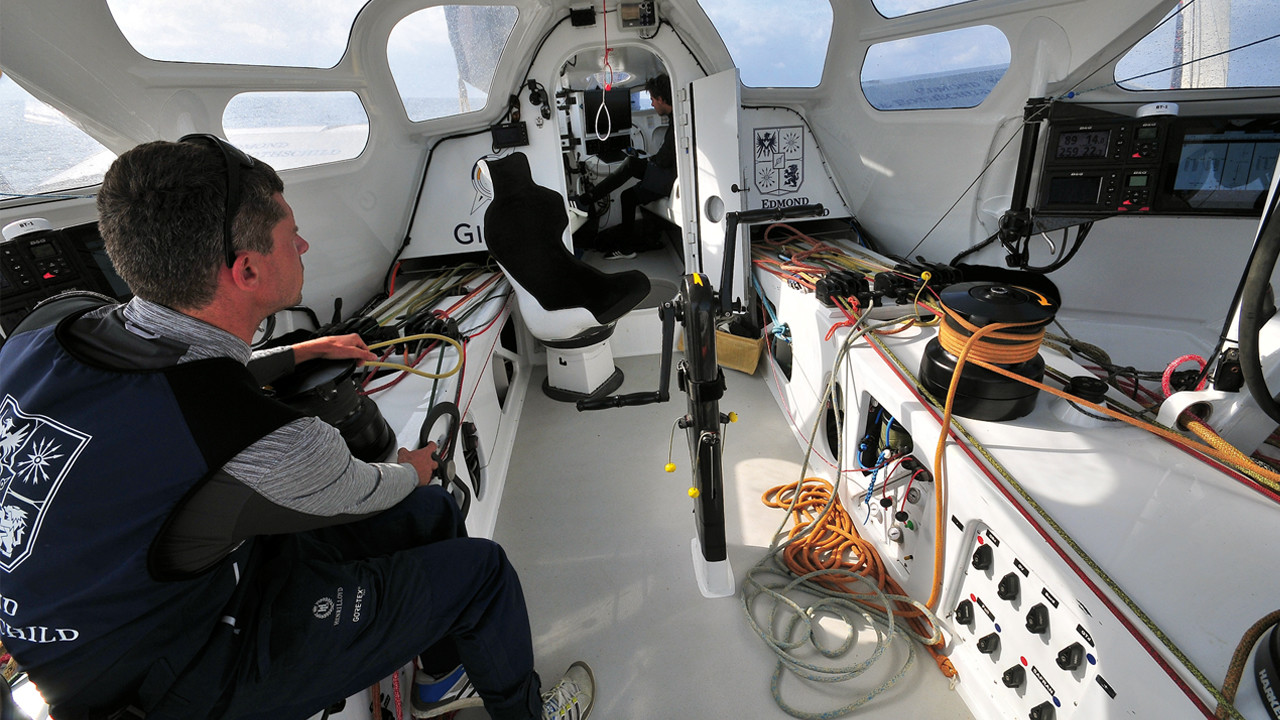
If Nicolas Lunven (weather) and Olivier Douillard (performance) manage to position the machine in good condition and a driver in shape on an optimized trajectory, the long flight sessions will allow a unique wake across the Atlantic. The English Channel, Biscay and The Azores are not short of rough crossings, delicate weather phenomena and crossed seas, all the opposite of the desired conditions for high speed. The bonus will go to the pilot who will fly the best and the most regularly, knowing that it is almost impossible to rest in these conditions...
At the helm, I observe the fantastic work of the foils and the careful preparation of this platform which provides extraordinary performance, and am fascinated by the snowy wake that we leave between Ile de Groix and Belle Ile! At 30 knots, on our way back, the perception of the entrance to the Chenal de Lorient is distorted and in a few minutes we are off the signal station, where the speed is limited to 6 knots! With all the sails eased, the 32m trimaran stops: it's over. All that’s required now is get the machine back alongside the dock using the 110hp engine and the two little tugs!
Technical specifications
Name: GITANA17-EDMOND DE ROTHSCHILD
Naval Architects: Team Verdier-Gitana
Builder: Multiplast/ Appendages by Eligio Re Fraschini-Heol- C3 – Persico (coachroof tip), mast by Lorima
Length: 32m
Beam: 23m
Laden weight: 15.5t
Mast height: 35m
Upwind sail area: 450m²
Downwind sail area: 650m²
Construction: honeycomb carbon-epoxy, hull bottoms in monolithic carbon
Decor on hulls and sails (800m²): JB Epron based on an original work by Cleon Peterson
Text: Philippe Echelle
Photos: Eloi Stichelbaut / Gitana SA and P.Echelle
What readers think
Post a comment
No comments to show.